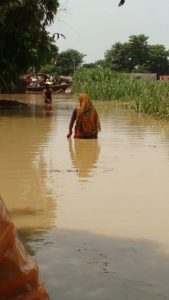Numerous communities have been affected in the wake of significant rainfall that has lashed the India-Nepal-Bangladesh region. Photos from these affected areas show people on boats and makeshift rafts, transporting their valuables to safer ground. Some depict people carrying their possessions on their shoulders in chest-deep water.
Between August 13 and 14, incessant rain along the Nepal-India border caused significant flooding in many districts of Bihar. On August 23, the situation worsened as the number of deaths mounted to more than 300. The deluge has affected nearly 14 million people in 18 districts. In Nepal, 50,000 people have been left stranded in the plain regions and a further 91,000 households have been temporarily displaced in 28 districts.

In Naya Tola Bishambharpur (NTB), in the West Champaran district of Bihar, the watery quagmire surrounding the village poses formidable challenges. NTB borders Nepal to the north, and the upstream precipitation in this region greatly influences the amount of water that flows down into the region. The map below shows that the entire western part of the district has been submerged in rain and flood waters.
Weekly spatial rainfall data analysis from the Indian Meteorological Department (IMD) shows that between August 10 and 16, West Champaran received between 240 to 600 millimetres of rainfall; received in such a short period of time, this amount has had lasting impacts on communities living in the district. The latest statistics show that there have been 13 deaths in the district alone due to flooding.

During floods, sanitation becomes a particular problem as people have reduced means of maintaining personal hygiene, especially with regard to defecation. Open defecation only adds to the contamination of ground water, which then affects those who use it for household uses. A workable solution would require addressing multiple needs regarding clean drinking water and secure sanitation.
To this end, the phaydemand sauchalaya, or eco-san toilet, was introduced in NTB to address the needs of safe and secure sanitation. Through its innovative structural design, it offers an effective means of addressing sanitation compared to standard flush toilets. In the alluvial flood plains of Bihar, the use of flush toilets increases the risk of contaminating the shallow water table. Such toilets also face clogging, raising the risk of infection for users, specifically women and children, in a region frequented with floods.
The eco-san toilet is constructed on raised platforms to ensure access even during flood conditions. The height of the toilets is determined based on the highest flood water levels anticipated in the area. The seat of the toilet itself has two different openings that collect urine and faecal matter. These openings are connected to two separate storage tanks below the toilet, which are situated above ground. Because the eco-san is a dry toilet, the breakdown of faecal matter creates no foul odour. The collection pits can be accessed by openings created by uncemented bricks positioned at the back of the eco-san toilet structure. Faecal matter now in its form as humanure can be applied to crops as fertiliser, and the urine as a urea substitute. As a flood adaptive technology, the toilet not only provides secure use, but due to its water-less design, also cuts the risk of groundwater contamination and successive infections entirely.

Live examples of toilets currently being used by households in the Kairi community in Paschim Champaran indicate a promising future for households in NTB. The village of Kairi in Gaunaha block of Paschim Champaran, close to the Nepal border, is in a region prone to flash-floods, and stands testimony to the effectiveness of eco-san toilets as a viable solution for sanitation in flood-affected regions. Since 2015, residents of the village have been taking up the construction of the toilets one by one, seeing the positive reaction from their neighbours who had already done so. On August 8, the flood waters rushed through the village entering homes, creating new channels for streams in the fields and even washing away an embankment of geo-bags along the Pandai River, on whose banks the village is located. But the eco-san toilet remained standing, and accessible. The flood waters that came to Kairi only remained for a few hours, but even at their peak level, the top steps of the toilet remained above the water.

Debabrat Sukla is the knowledge management focal point for the Hi-Aware initiative at Icimod.
Anjal Prakash is programme coordinator (Hi-Aware), and coordinating lead author for the upcoming AR6 report on oceans and the cryosphere, by the IPCC. Aparna Unni is a programme officer (water) at Megh Pyne Abhiyan.
![<p>A woman indicates the last flood water levels that inundated the Kairi village. The toilet was still accessible [image by: Aparna Unni]</p>](https://dialogue.earth/content/uploads/2017/09/Figure-6.jpg)
